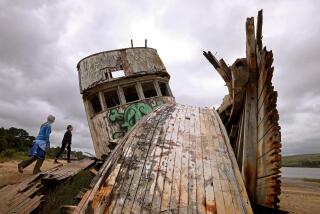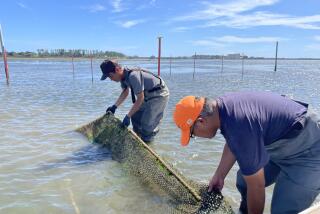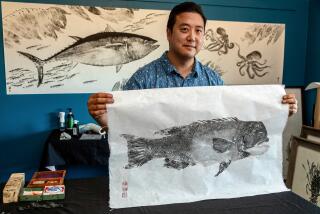HUNKY DORY : Plucking Fish From a Dangerous Ocean in a Small Boat: ‘This, It’s Not Easy, You Know?’ Says One Who Does It
Onshore, the bright orange morning sun has just begun to show behind the towers of Newport Center, nearly 4 miles to the north, as Nick D’Amato falls into a relentless, flailing working rhythm aboard his tiny boat.
He exhales sharply and his features pinch as he jerks fish after thrashing fish from the rising line with his gloved right hand and flings them into the stern of his boat with his ungloved left. The winch pulling up the line grinds on and on.
Every minute or so, two or three hooks in succession come up empty, giving D’Amato a few seconds to sag back against the gunwale and make the most unnecessary pronouncement of the day:
“This, it’s not easy, you know?”
Hauling several hundred pounds of fish out of the channel that separates Catalina from the mainland and into a boat only 18 feet long--and doing it nearly every day--may qualify as one of the least easy jobs in Orange County. In fact, from an outsider’s perspective, it looks to be slightly less cushy than dismantling unexploded bombs.
But for 14 years, it has been D’Amato’s bread and butter. During that time, he and his little boat have motored out into the channel in fair and foul weather, often working in darkness and fog and wet cold, in high waves and cutting winds and through hours of lonely, muscle-straining work.
Still, D’Amato said, it would have been unusual if he had not turned to the fisherman’s life when he arrived in Orange County.
Born and raised in the Sicilian town of Porticello, near Palermo, D’Amato, 42, said that when he came to live in Costa Mesa with his American-born wife, Julie, in 1974, he worked for a time for a local electronics company assembling computer boards. Then he discovered the dory fleet and his heritage was revived. His family, he said, has produced fishermen for many generations--”all of them, all the way back.”
“When I saw they were fishing here, I said, ‘That’s what I do. That’s my job.’ ”
And with that, he began his tenure as a doryman, giving up late sleeping, certain income, safe working conditions and unscored hands.
Abstractly, D’Amato’s job is simple. He catches fish and sells them. No time clock, no bosses, no one telling him how to run his business.
In reality, however, D’Amato and his fellow dorymen must obey two of the grimmest taskmasters known--nature and public demand.
Some days, the waves are too high, or the fish won’t bite, or they catch fish that won’t sell. And even if they have a good day, maybe the customers will stay home and opt for chicken, or they may not want the kind of fish caught that day, or they may not feel like coming out in the wind and the spray and the cold, gray weather, even if the dorymen did.
But early in the morning, in the dark, when most people have been asleep for only 3 or 4 hours, D’Amato tows his dory, painted with the Italian tricolor stripes, down to the surf near the Newport Pier to begin another day.
Dory fishermen have been performing that ritual in Newport Beach since 1891, when a Portuguese fisherman began selling fish at the beach out of his dory, rather than having them hauled to market. The only substantial difference over the nearly 100 years is that oars have been traded for powerful outboard motors on the boats.
Currently, there are 16 fishermen in the dory fleet, and they are likely unique in California. Don Schultze, a marine resources supervisor for the state Fish and Game Department, which licenses the dory fleet, said: “I don’t believe there’s a comparable fleet elsewhere in the state. It’s a pretty unique operation, launching directly off the beach like that.”
On this day, D’Amato’s lines have been set only about 3 miles off the Newport Beach shore, and it takes less than 10 minutes to motor out to the marker buoy he has left the day before. (Depending on the season and where the best fish can be found, the dory men sometimes venture 20 miles out to sea.) However, he must first launch his craft and drive it through the shore break at the pier.
This morning, the waves are slight, but D’Amato said larger ones do not keep him and his colleagues from their business. Ask about them, though, and you get a quick shake of the head and a groan.
“Pretty big,” he says.
His flat-bottomed dory is a quick boat in the calm water, making an estimated 22 knots. D’Amato stands holding the wheel, steering into the gentle oncoming swells, immobile, as if he has been nailed fast to the deck. He wears a knitted cap to keep the wind off but keeps his face into the spray.
His hands are so cracked and calloused from years of handling lines and knives and gaffs and fish that a hook wouldn’t dare to try to lodge in them. Several hours of exposure to cold and sea water can soften them and turn them raw, however. The palms and fingertips will soon turn nearly ivory white, especially those on the ungloved left hand.
Today, D’Amato must retrieve only two lines and one unbaited anchor line (other days, he said, he often sets more). But each line, he said, is about a mile long and is set with about 600 hooks. Also, at intervals along the line are tied both empty glass bottles and half bricks, in order to keep the line relatively stationary in the depths. At today’s spot, the lines are trailing down into about 1,100 feet of water.
To raise the line, a hydraulic winch is used, powered by an inboard gas engine. D’Amato stands next to the winch as the line feeds through it, controlling its speed with a short handle. He rarely touches the handle, however, preferring to pluck the fish from the line as they rise to the winch; the line is allowed to trail into a plastic bucket. As the bricks and bottles appear, he quickly unties them or, if the knot will not yield, grabs a nearby knife and cuts them free of the line, tossing them into buckets for use the next day.
For the next 2 hours, D’Amato’s gaze is focused not on the spectacular dawn or the lovely, glassy sea or the gulls wheeling overhead, but over the starboard side of his boat, about 10 feet below the surface of the green water, where the fish on the line are beginning to appear from the depths.
“Look at this, look at this,” he says, beckoning. “Come here, you got to be quick.” A large red snapper, perhaps 3 feet long, is coming up. For this prize, D’Amato stops the winch, wrestles the fish off the hook and deposits it in the place of honor, on a thwart next to the inboard engine.
For the rest of the morning, most of his catch turns out to be sea trout, with a smaller haul of red snapper. As the catch changes, so does his mood.
“Another whitey,” he grumbles as he slings another haddock into the boat. “The people don’t buy as many of them. They want the red snapper.”
And there are periods when hook after hook rises with the bait nibbled or snatched away cleanly, or with the remains of a fish that has taken the bait only to be mostly eaten or mauled by a still-larger fish. D’Amato holds up one sea trout that has been almost cleanly bitten in two, nods at a pair of sea lions feeding nearby and shakes his head.
“This is what they do. A lot of people out here don’t like them. They’re good animals, and I would never kill one, but sometimes I feel like they cheat me.”
Things look up, however, a few minutes later when the second line brings up a steady stream of sea trout.
Finally, the entire available bottom of the boat, along with two plastic tubs, is piled ankle-deep with fish, and D’Amato turns the dory for home. The laden boat moves more sluggishly this time. It is about 8:15 a.m. Reaching the shore break in front of the dory fleet’s beach, he guns the motor at the crest of a wave and rides it smoothly in, the boat scraping to a stop in the sand.
His son, Onofrio, 17, arrives quickly with the trailer--not to pull the boat onto shore, but to cart tub after heavy tub of fresh fish a few yards up the beach to the D’Amato family fish stall where, beneath Perrier and Cinzano umbrellas, customers wait. The stall, as well as other dorymen’s stalls, opens for business immediately after the boat returns.
While D’Amato weighs the fish and talks with customers, Onofrio cleans the fish at an adjacent cutting board with a flashing knife, turning whole fish into table-ready fillets in seconds. His wife wraps them in butcher paper and newsprint. The selling will go on into the late afternoon, when the other two D’Amato children, Veronica, 15, and Giacomo, 11, often arrive to help wrap fish and attach anchovy bait to the lines to be set for the next day’s catch.
The haul this day, Onofrio said, is better than average, perhaps 1,000 pounds of fish. Those that the family does not sell to oceanside customers will be offered wholesale to restaurants and markets.
Income, D’Amato said, is never dependable, and, because competition between them is keen, he and other dorymen are reluctant to discuss it. What with boat repairs, the price of bait and other continuing overhead costs, there are lean times as well as relatively prosperous ones. A good catch, he said, can be followed by several bad ones, and vice versa.
After years of fishing in both Sicily and California, D’Amato has no romantic illusions about his work. He says he believes that the labor has aged him beyond his years. He does not want or expect to fish into his later years.
However, the family tradition is not likely to end when he hangs up his knit hat for the last time. Onofrio remains excited about the life.
“Onofrio would go out with him when he was about 7 years old,” said Julie D’Amato. “A couple of years ago, he started going out with him all the time. Six months ago, he started going by himself.”
Today, D’Amato and his son will sometimes spell each other, one setting the lines, the other returning later to haul in the fish. It is a schedule that requires special accommodations for the high school-age Onofrio. He attends Back Bay High School in Newport Beach and is enrolled in a program that allows him to attend class once a week, at which time a week’s worth of homework will be assigned for him to complete after working hours.
“I like fishing,” he said. “I’ve liked it since I was real young. It’s a real challenge to see how much fish you can actually get under all conditions.”
He has had close calls in his young career.
“Oh, yeah, plenty in bad weather,” he said. “It’s scary. Sometimes, you wonder if you can make it in. The winds get so strong and the swells get so big. But you feel like you’ve accomplished something; that’s for sure.”
More to Read
Sign up for Essential California
The most important California stories and recommendations in your inbox every morning.
You may occasionally receive promotional content from the Los Angeles Times.









